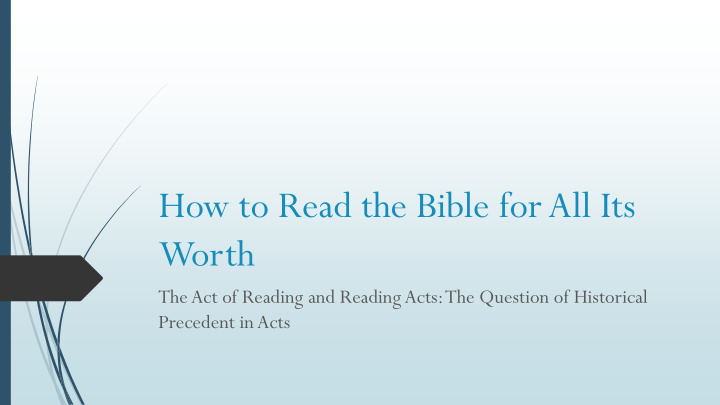



How to Read the Bible for All Its Worth The Act of Reading and Reading Acts: The Question of Historical Precedent in Acts
I. The Act of Reading Reading is a skill In 1820, 12% global literacy Reading well is even more difficult skill––it takes practice! We need our reading habits retrained
II. Reading Acts: The Question of Historical Precedent How to read Acts well? Can Acts serve as a precedent for us today?
“Paul gathered a pile of brushwood, and as he put it on the fire, a viper fastened itself on his hand … But Paul shook the snake off into the fire and suffered no ill effects.” Acts 28:3–6
Hermeneutical guide-post #1 In historical narrative, description does not equal prescription
Overall, total pattern in Acts (i) the story begins with proclamation of Jesus in Jerusalem with a purely Jewish church, with Peter as leading character (Acts 1–6) (ii) moves toward proclamation of Jesus which includes Gentiles in Judea and Samaria, with Stephen, Philipp, and Peter leading (Acts 7–11) (iii) and finds its goal with proclamation of Jesus reaching the whole Gentile world and ending in Rome, the capital of the Gentile world, with Paul as leading character (Acts 12– 28)
Fee and Stuart: “The model [in Acts] is not so much in the specifics as in the overall picture. By the very way God has moved him to structure and narrate this history it seems probable that we are to view this triumphant, joyful, forward-moving expansion of the gospel into the Gentile word, empowered by the Holy Spirit and resulting in changed lives and local communities, as God’s intent for the continuing church. And precisely because this is God’s intent for the church, nothing can hinder it, neither Sanhedrin nor synagogue, dissension nor narrow-mindedness, prison nor plot. Luke, therefore, probably intended that the ongoing church should be “like them,” but in the larger sense, not by modeling itself on any specific example.”
How should the church look according to Acts? Evangelistic Christ-centered Spirit-empowered Strong community open to all
Hermeneutical Guide-post #2 In historical narrative, the total pattern is king In other words, when reading the narrative constantly ask this question: what function does this individual passage have within the whole story and total context?
III. Exegetical Example: Acts 6:1–6 “In those days while the disciples were growing, a complaint by the Greek-speaking Christians came against the Aramaic-speaking Christians, because the widows of the Greek-speaking Christians were being neglected in the daily distribution. So the twelve called the whole crowd of disciples to them and said, ‘It is not right for us to stop proclaiming the word of God in order to serve the tables. So, brothers, pick out seven well-attested men from among you who are full of the Spirit and wisdom, and we will appoint them to this need. We will continue to be devoted to prayer and to the service of the word.’ And the decision pleased the whole crowd, and they elected Stephen, a man full of faith and the Holy Spirit, and Philipp, and Prochorus, and Nicanor, and Timon, and Parmenas, and Nokolaus, a convert from Antioch. And they stood before the apostles who prayed and laid their hands on them. And the word of God grew and the number of the disciples in Jerusalem grew exceedingly, and a great crowd of priests became obedient to the faith.”
What function does this passage have within the total story and whole context of Acts? Not about church government => establishing role of “deacon” Shows how early Christians creatively worked through conflict and provided for widows’ needs Sets the scene for expansion of Christian message outside its Jerusalem base
Keep Reading Reading as practice => practice reading the total narrative
Recommend
More recommend